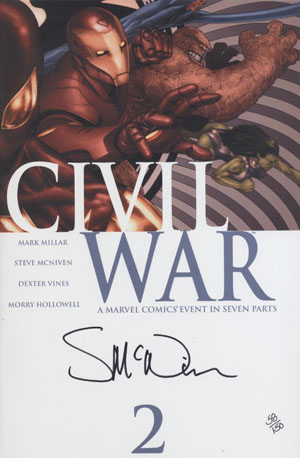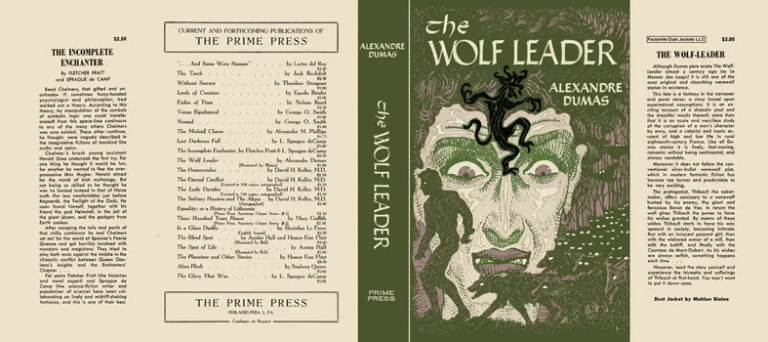 Civil War #2 (originale dell’agosto 2006). Il numero si apre con l’ultimo di una lunga serie di "arresti" operati da Capitan America ai danni di quindici supercriminali, lasciati poi impacchettati allo S.H.I.E.L.D.: il messaggio dell’azione è semplice. Steve Rogers si è dato alla clandestinità ma non per questo ha perso di vista il bene comune, anzi, si pone come colui che realmente lo sta perseguendo. Non solo. Quindici arresti di superceriminali in settantadue ore, come rileva il comandante S.H.I.E.L.D. Maria Hill, non possono essere stati portati avanti da Capitan America da solo: le file dei ribelli si sono ingrossate e Steve vuole farlo sapere.
Civil War #2 (originale dell’agosto 2006). Il numero si apre con l’ultimo di una lunga serie di "arresti" operati da Capitan America ai danni di quindici supercriminali, lasciati poi impacchettati allo S.H.I.E.L.D.: il messaggio dell’azione è semplice. Steve Rogers si è dato alla clandestinità ma non per questo ha perso di vista il bene comune, anzi, si pone come colui che realmente lo sta perseguendo. Non solo. Quindici arresti di superceriminali in settantadue ore, come rileva il comandante S.H.I.E.L.D. Maria Hill, non possono essere stati portati avanti da Capitan America da solo: le file dei ribelli si sono ingrossate e Steve vuole farlo sapere.
Dall’altro lato IronMan e i Vendicatori continuano le loro operazioni di recupero dell’immagine, in casa Richards c’è qualche discussione e Patriot dei giovani Vendicatori tenta di sfuggire all’arresto per aver tentato di sventare una rapina. In breve, il numero è costruito tutto su uno scontato montaggio alternato tra "governativi" e "resistenza". Il punto centrale resta sicuramente la conferenza stampa di Tony, in cui Spiderman rivela al mondo di essere Peter Parker (e il direttore del Daily Budgle sviene). Si rivela anche in parte la composizione della squadra di ribelli, ma poco altro. A parte la finezza di non mostrare mai né Capitan America né un redivivo Nick Fury, la storia imbastita da Mark Millar in questo numero è abbastanza povera.
Una domanda in chiusura: perché durante la conferenza stampa Peter Parker indossa il vecchio costume? Forse Steve McNiven non sapeva come disegnare la scena in cui si toglie la maschera? Fatto sta che mi sarebbe piaciuto veder risolto il mio dilemma su come faccia a uscire da quella corazza. Pazienza.
L’imputato #2 e #3 (The Accused #2 e #3 da Civil War – Front Line #2 e #3 rispettivamente dell’agosto e del settembre 2006). Il vero pezzo forte dell’albo, che vede Paul Jenkins allestire una bella vicenda attorno a Speedball in carcere. Se inizialmente mi era sembrato un bamboccio senza spessore, leggendo questi due episodi mi sono dovuta ricredere: non solo ha molto senso il suo rifiuto ad accettare la grazia del governatore e a firmare l’atto di registrazione, che equivarrebbe ad un’ammissione di colpevolezza, ma – seppur breve – l’evoluzione da "voglio vedere il mio avvocato" a "ci incontreremo sul ring della prigione tutte le volte che avrai il fegato di farlo" e "bravi fascisti! vi ho fatto arrabbiare, eh?" ha molto senso ed è molto ben delineata. Anche il personaggio di Jennifer "She Hulk" come suo avvocato è piuttosto ben tratteggiato e mi piace sempre vederla nei panni di professionista in tayeur viola.
Cellula dormiente #1 (Sleeper Cell #1 da Civil War – Front Line #3 del settembre 2006). Sette paginette inutili e mal disegnate di cui non ho capito niente. Un negozio esplode, segue confuso flash-back (reso malissimo, tra l’altro). Mi farà un favore chi mi spiegherà che cosa è successo.







6 Comments
haljordan23
Posted at 20:08h, 14 Aprilletto in originale…non anticipo niente,ovviamente.
comunque il perchè Spidey è con il costume vecchio è spiegato nei tie-in su Amazing Spiderman
Shelidon
Posted at 08:52h, 15 AprilMe l’hanno detto. Mi hanno detto anche che il costume nuovo cambia foggia a comando mentale e che quindi non ha senso che la povera zia May si sia messa a cucirgliene uno in fretta e furia… ti torna?
haljordan23
Posted at 19:39h, 15 Apriltorna torna…per fortuna che è temporaneo…entro fine saga sparisce…leggere per credere!
Shelidon
Posted at 23:01h, 15 AprilQuel costume è veramente orribile… Tony l’ha trasformato nel suo giocattolino. Tremendo.
haljordan23
Posted at 11:21h, 16 Aprileh eh,continua a leggere…
Shelidon
Posted at 19:34h, 16 AprilSì, sì, so (quasi) tutto.